
WordPress for on page SEO should become 2nd nature for you. Although most of SEO these days is about more than just on-page signals, more on content which satisfies search intent, you still have to have the right "markers" in place to ensure that the web crawlers can get stronger signals about what the page is about.
So how do you optimize your WordPress site to be search-engine friendly? What do you do if you want to organically increase website traffic?
{autotoc}
You can start with the following on page seo checklist. This is the same process we use for our own website. Let's divide this on page seo tutorial into three parts:
- One-time blog setup adjustments - do those just once, reap the benefits for months to come.
- Plugins to have - let's be honest, you need some plugins for good optimal WordPress on page SEO. Not a lot, though. In fact, just 3 will do.
- Things to do for every new post - go through this part whenever you're just about to hit the Publish button for a fully on page SEO optimized post.
Recommended Supplementary Reading for Joomla guys: 21 Joomla SEO tips that every website should enable
Before we begin, these tips are meant primarily for self-hosted WP sites, as opposed to sites on WordPress.com which have more limitations on what can be done. Read about this difference on this CollectiveRay blog.
1. WordPress on page SEO - Make sure your indexing settings are enabled
Our first and most important part of this on page search engine optimization checklist is making sure your site is Googlebot friendly!
Google will only index your site if WordPress allows them to do so. There's a small setting in the Settings > Reading section of the wp-admin. It's called Search Engine Visibility. Make sure that the box is deselected:

If it's enabled, for let's say, development purposes, you'll need to make sure it's been switched off to enable your site to get indexed by search engines - otherwise, all the rest of your efforts will be for nothing.
Your site should also have a robots.txt that allows search engine crawlers to index your site. Check out your domains robots.txt, found at www.domain.com/robots.txt and make sure there isn't something that completely disables crawling by search engines.
For example, the following code would block all search engines from accessing your site!
User-agent: * Disallow: /
If you're not sure about this, you're typically better off without anything in your robots.txt.
Once you have verified that this is working ok, you'll need to check another setting. All of your pages that you want search engines to see and index should have a "meta robots" tag, that says something like "index, follow". If there is no robots tag specified, this implicitly means that the page is crawled.
This setting can be altered by SEO plugins that we will discuss later on in this article. If it is changed to "noindex, nofollow" - this means Google and other search engines will skip over this page, or site completely.
2. Optimize URLs for on page search engine optimization
Permalinks represent how WordPress structures every URL that is part of your site.
Unfortunately, the default WordPress settings aren't very on page SEO-friendly. A clean install of WP uses links like so:

While you want them to be:

You can set those in Settings > Permalinks. The idea is that in a setup like that, you can include keywords in your posts' URLs which is very important for WordPress on page search engine optimization.
3. Check how your theme handles headings - H1, H2 tags
We are now actually getting to the optimization checklist of actual items on your page, post or article.
A very important part of your onpage seo techniques is your content headers. The H1 to H6 tags are a critical part of your on-page search engine optimization structure.
For years now, those headings have been used to notify the reader (and also the search engines) what the hierarchy of the information on the page is, and what's more and less important.
The idea is simple:
- H1 - main, top-level heading - it's what the page is about. It's somewhat of a standard to only use one H1 tag on a single page. Google also recommended that H1 should be used more than once in the past so don't put multiple H1 tags
- H2 - secondary heading - it's what a section on the page is about.
- H3 - third level heading ... and so on.
Using a specific keyword in the H1 and at least one other heading will usually mean that your page is onpage optimized for those keywords.
It is also very important to check how your theme handles those headings. To do so:
- Visit any given post.
- View source by pressing Ctrl+U (Windows) or ⌘-Option-U (Mac) in most web browsers.
- Press Ctrl+F (or ⌘-F) to find all instances of H1 and H2 tags. See if they make sense and present a good structure of the document:

Have an H1 on each page
Every page on your website should have an H1 heading which explains to both humans and search engines that your page is about (including keywords that you want to rank for). In general, having "front-loaded" keywords, i.e. keywords that appear at the beginning of the H1 is better, but make sure that the h1 heading makes sense for humans.
What we mean by this is that you shouldn't optimize for search engines to the point where the title no longer makes sense for humans.
For example, you can see how we used the keywords "WordPress On Page SEO Checklist" in the header of this page. We could also have used "How to do On Page SEO for WordPress". It is usually best to test different combinations and see what works best in terms of rankings.
Use another heading with a variation of your keywords
To make it clear to search engines what your page is about, you should also use your keywords or a variation of their sequence in at least one other heading (that is not the h1). You probably shouldn't be using in EACH heading, because at that point your page becomes "over-optimized".
This is the point where there are TOO MANY keywords on the page.
In general, even though you should keep usage of keywords in mind, just make sure that usage of such keywords is natural and flows with the rest of the content on the page.
4. Improve your site speed
When performing your on-page seo checklist, do make sure you've checked how fast your website loads.
Site speed is yet another element that Google pointed out as one of the ranking factors. And it's not only words, but it's also actually been proven experimentally that site speed strongly correlates with search engine position. Although, some latest reports say that it doesn't - there are conflicting opinions these days.
But there is one thing which is definitely affected by a good page loading speed - this is user experience and conversions. A fast website is good user experience, and a good user experience translates to more conversions.
What this means in plain English is that you should do whatever it takes to make your site load as fast as possible. Even setting search engine rankings aside, good site speed will improve the overall experience that your audience has with the site. There are a lot of on-page benefits or WordPress sites that can get their load time to less than 2 seconds.
Site speed is such an important factor, that the Google Search Console that we have mentioned above has actually created a new tool which specifically indicates the pages that are "slow" on mobile.
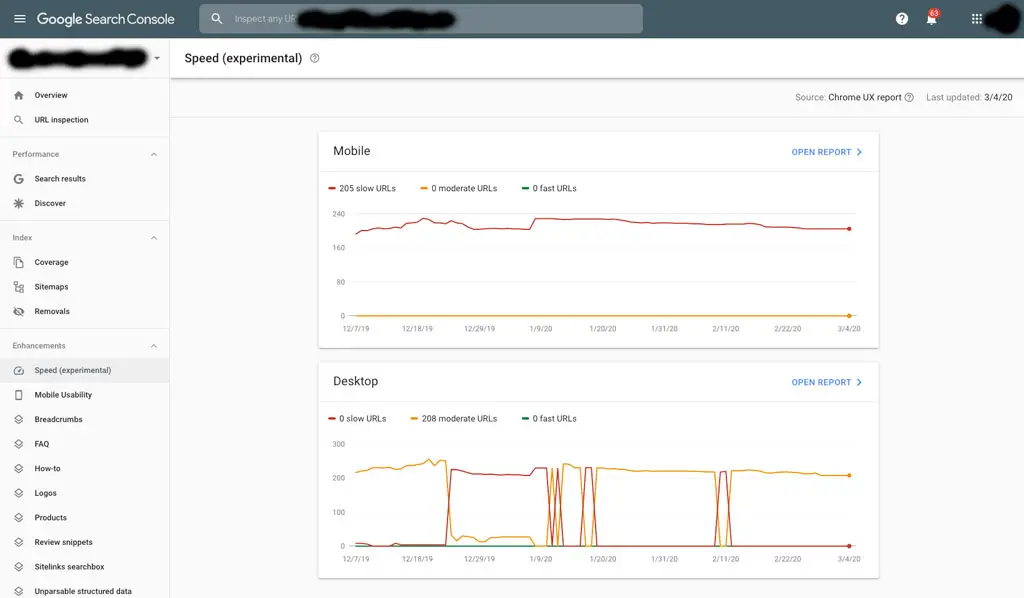
How to make your site faster? I'm afraid there's no one-sentence solution for this. Below is a 21 step-by-step guide that we've built over a number of years. It talks about all the how's and why's and lists a number of optimizations you can perform to make your website faster.
If you want one plugin which can do a significant amount of difference to your website's speed though - do have a look at WP Rocket. It's our recommended plugin of choice to make your website faster incredibly quickly.
It's not free - but it's well worth the investment! - Get it from here, install and make your site faster in minutes.
Recommended Reading: How to get fast WordPress website - a complete guide [21 actions]
Read More: How to Leverage Browser Caching in WordPress with (or without) a Plugin (https://www.collectiveray.com/leverage-browser-caching-wordpress)
What we are going to say, though, is that the best way to make your site faster is to simply switch to a faster hosting platform. Sometimes you just can't make up for the shortcomings of your web host by doing WordPress onpage SEO tweaks. That's why changing your hosting provider is often the quickest and also the best solution.
If you're looking for a great fast hosting service, we absolutely love InMotion hosting - we do strongly suggest you visit our review here.
If you don't know how to find a fast host, we encourage you to hop over to our web hosting reviews section - it's a comprehensive ranking focusing mainly on the site speeds you can get from various hosting providers.
The list is kept up-to-date, so you can visit it in the future as well.
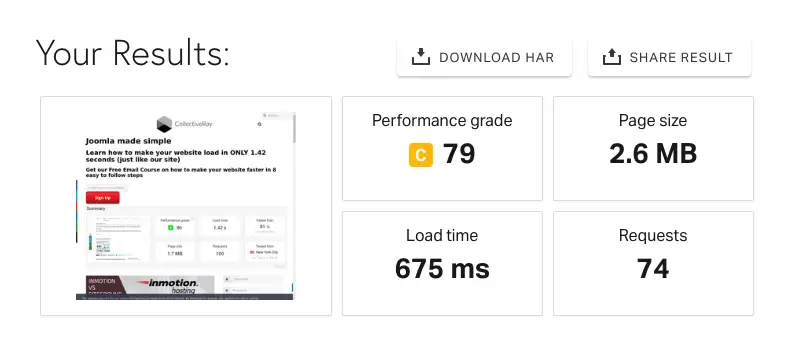
5. WordPress On Page SEO Plugins to have
Let's move to the plugins department. As we said at the beginning, working on your WordPress on-page SEO without plugins can only take you so far. The thing is that WP isn't that SEO-friendly right out the gate, which leaves a lot of room for plugins to come in and fill the gaps.
SEOPress
Let's start with SEOPress: we've reviewed this tool in detail here.
This is one of the fastest-growing WordPress on-page SEO plugin options, with more than 300,000 installs at the time of writing.
It gives you all the basic settings you'd need, and also lets you in on some of the advanced stuff, should you want to experiment. We dare say that this is the one on-page seo tool that you cannot do without.
Some of the things you should do right away after installing it:
- Change the default title and description of your homepage. Do it in SEO > Titles & Metas > Home. We'd advise you to target some long-tail keyword in your homepage title that also includes a shorter keyword in it. That way you're killing two birds with one stone. Example: for this page we're targeting "WordPress on page SEO", which means, we're also targeting "WordPress SEO" and "on page SEO"
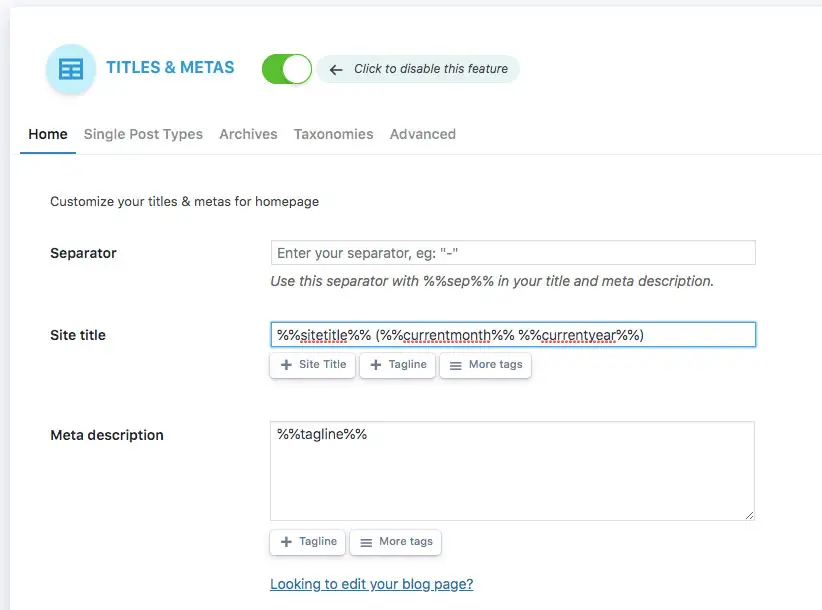
- Do the same for your Single Post Types and Taxonomies (available as tabs in SEO > Titles & Metas).
- Generate a sitemap. Go to SEO > XML / HTML Sitemap:
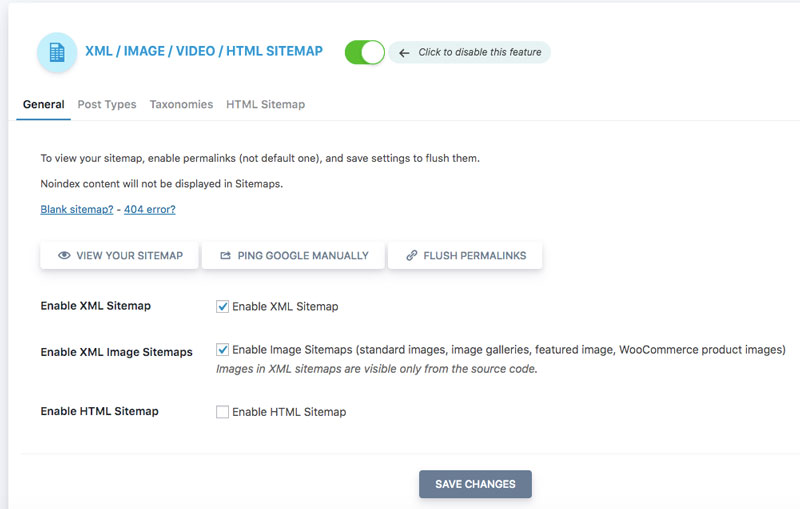
- Prevent duplicate content by not indexing the archives pages. Go to SEO > Titles & Metas > Archives:
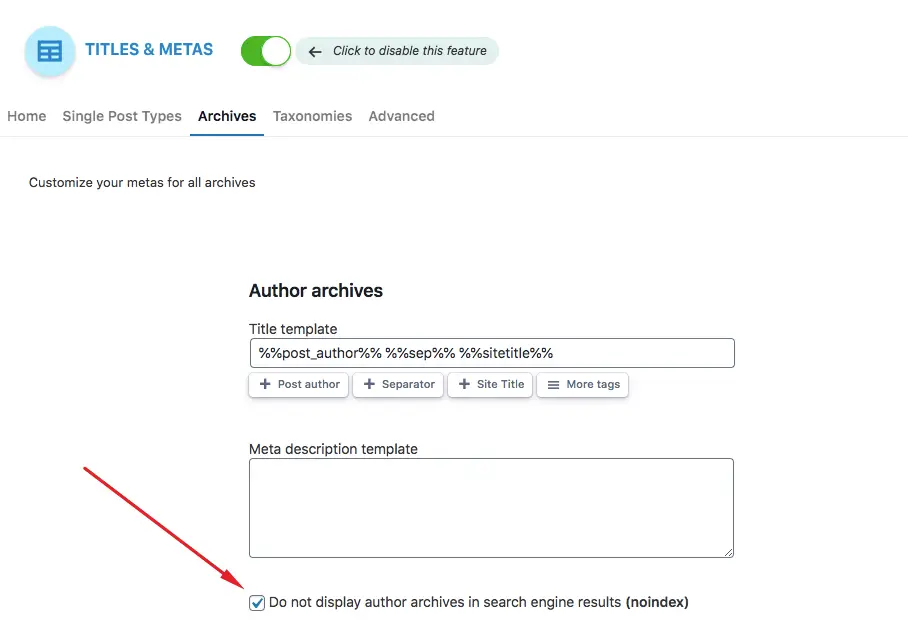
You can also opt for the PRO version of the plugins at the ridiculously low price of $39 per year, to get stuff such as Structured Data Markup, a Redirect Tool and Broken Link Checker, WooCommerce Integration and Optimization, Video XML sitemaps and many more features.
The SEO Framework
As somebody who has been in the industry for a while, we are always looking for the next big thing, and we think we might have found a strong contender for the title of best plugin for on-page search engine optimization.
It's called The SEO Framework and has been picking up a lot of traction recently.
Not only has it become popular, but it's rated 4.9 stars from nearly 160 votes as at the time of writing. And we don't say this only through third-party experience. We've actually used the plugin ourselves and have found it to be extremely useful, in certain aspects exceeding our expectations in terms of the suggestions it makes to users who are writing to make sure their content is fully-optimized for search engines (and users!)
For example, the Focus extension allows you to find synonyms of your target keywords, such that you write content both Google and your users will love, without exceeding the recommended keyword density and also writing naturally.
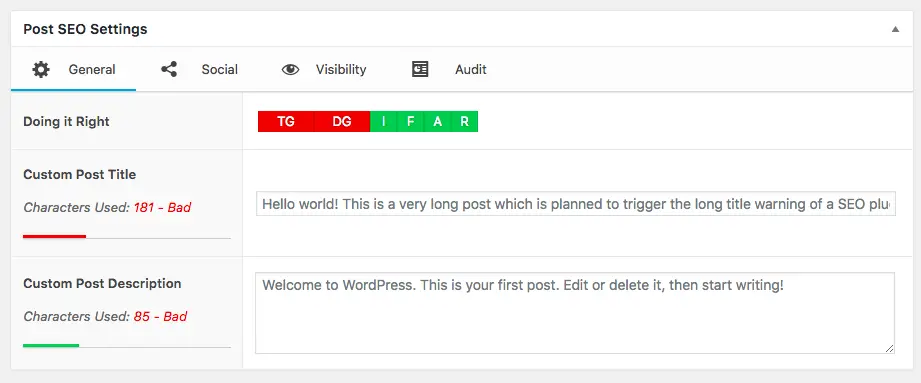
Rank Math
Rank Math is also a fairly recent entry into the SEO plugins game, though now it has some good history on it.
Rank Math eliminates the complexities of SEO with its user-friendly interface and step-by-step setup wizard. It intelligently configures your website's SEO settings, saving you valuable time and effort with little SEO expertise required.
Some of the noteworth features are:
- On-Page SEO Optimization: Optimize content for target keywords with real-time SEO scoring and actionable suggestions.
- Technical SEO Made Easy: Rank Math handles technical SEO aspects like XML sitemaps, robots.txt generation, and schema markup.
- Rank Tracking and Competitor Analysis: Monitor keyword rankings, identify competitor strategies, and stay ahead of the curve.
- Seamless Social Media Integration: Effortlessly integrate social media profiles for a more comprehensive online presence.
- Rich Snippets and Schema Markup: Generate rich snippets and schema markup for content, leading to potentially higher click-through rates in search results.
- Local SEO for Brick-and- Mortar Businesses: Optimize website for local searches if you have a physical location.
Note that you only need to have ONE of these plugins, with our preferred choice being SEOPRess.
6. Add Structured Data (including FAQs where necessary)
So the biggest "challenge" that Google has, in general, is understanding content, what it is about, who are the entities (authors, organizations) behind it, and how these entities interrelate.
Google is hundreds of algorithms that try to make sense of the complex nature of the web. So what if you could actually make it easier for Google to understand your data?
This is the purpose of "Structured Data". It is a way to markup your content to make it more understandable to Google and other search engines. You can create such markup as:
- Organizations
- Authors
- Products
- Critic reviews
- Recipies
- Movies
- Events
- Local Business
- Course
- Video
- Job Posting
- Frequently Asked Questions
- How To
- Fact Check
- ...and more
When using such structured data on your website, Google can show your website in rich results, that essentially are showing more detailed information in the engine result pages.
For example, products look like this:
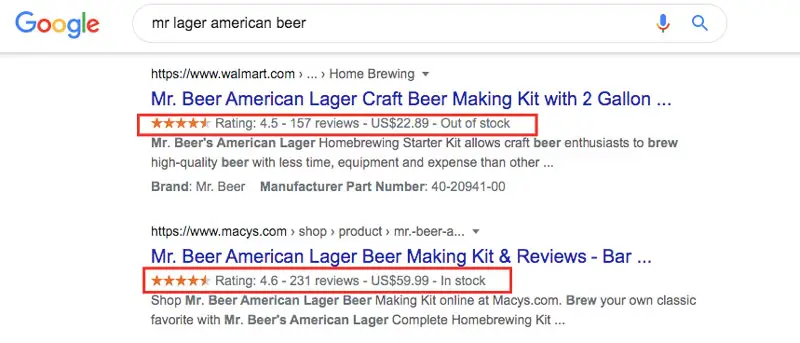
while critic reviews look like this:

FAQs, on the other hand, take a lot of real-estate in the actual search results because they appear right under your listing as you can see below:

As you can see most structured data, not only help Google understand your content better, but also give you better or richer results in the search engine result pages. When you're competing for every click, you'll want to take every advantage you can get.
If you want a plugin to help you with this, we'd suggest opting for SEOPress as we have suggested above.
7. Use keywords in two-fold headlines for improved keyword targeting
Twofold headlines are a really clever concept. Basically, the idea is to make your headlines optimized for the search engines and for humans both at the same time.
You need to construct your headline from two parts:
- the keyword-rich search engine optimized part, and
- a twist.
Examples:
- How to Create a Killer "Hire Me" Page,
- Instead of a "Hire Me" that Pushes People Away
and
- 10 "Blog Post Ideas" so Great They'll Make You Want To Slap Your Mama!
- These are "Blog Post Ideas" that People will be Proud to Share
This sets the right tone, both for users and for search engines. The great thing is that you can use your primary and secondary keywords in the headlines.
This is a really important step in your on-page SEO checklist.
8. Create a Title / Description that is focused on getting clicks
This is a must-do for every new post. Scratch that, this is something that you should revisit often for every post that is important to you. Don't be lazy with this and give it a LOT of attention.
While WordPress will fill out the meta title and description fields for you, those auto-generated texts aren't always the best, both from a keyword optimization perspective and a copywriting perspective.
In reality, you'll need to focus on creating a Title and Description that will entice your users to read your article. Besides using such stuff as power keywords, you'll want to focus on having stuff such as the following in both the title and the description:
- Power words (boost, increase, power, always, jumpstart, never)
- A powerful sentiment or emotion
- A number (preferably odd, 7 Ways, 21 Things, 19 Facts)
- User brackets such as () and [] (e.g. [Buying Guide])
- The year (current or next, and also month, you can use such stuff as %%currentyear%% if your SEO plugin supports it)
- Cliff-hanger ... You Won't Believe What Happened Next (not spammy like this but you get the point, stuff such as "Find Out")
You can use a headline optimizer to help you make the headline as powerful as possible.
You can use a similar concept in the meta description. Creating a cliff-hanger in the meta will help boost the CTR (click-through rate) and increase rankings.
Also, the Title should be identical to the H1. This is because of they are identical, Google is less likely to reword the Title tag in the SERP results, which they can opt to do. Tests from SEO have shown that an H1 that is identical to the Title is more likely to stay untouched.
If you have SEOPress or another plugin installed, you get a nice box under the main editing screen to take care of this:
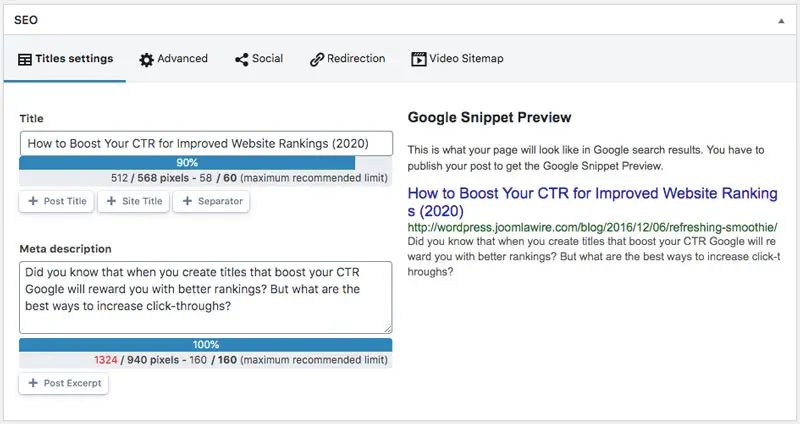
Use your main keyword for the post title, and also some related keywords in the description.
You should also focus the same level of importance on the description. Create a Meta Description that is enticing to the end user. We also like to Capitilize The Keywords to make the stick out in the search engine results.
But having a clear description that entices the user to click can work wonders for a good CTR (click through rate).
9. Include the primary keyword in the first paragraph
The first paragraph is the most important part of the post's content from a search engine optimization point of view. You simply need to let Google and your visitors know what your post is about. Preferably even in the first sentence, but definitely in the first 100 words.
This may require some thinking to make things sound right, but you should always make an effort to include your main keyword in the very first paragraph.
Scroll to the top of this post to see how we have included our primary keywords in the first sentence, literally the first few words of the article.
10. Keyword usage is Important
If you want to rank for a certain keyword, you need to mention that keyword some number of times in the body of the post, together with a number of variations of that keyword that mean the same thing but people also use.
The team behind Yoast recommends anything from 0.5-2.5% density, but these are old recommendations in reality. A better approach would be to use a keyword density that is in line with what the top-ranking pages for that keyword.
So if the top 10 search results are using it less than 0.5% of the time, then that is your guideline. If they are using it 3% of the time, then you should also use it 3% of the time.
The SEOPress and other plugins usually have an on page seo analyser that lets you know about your current keyword density score and other optimizations you should perform.
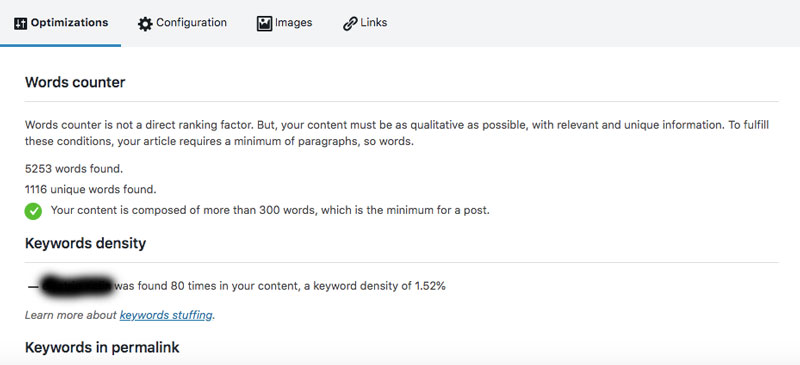
As part of your on-page search engine optimization, try not to over-optimize or use keywords such that they do not make for good reading. Which brings us to the next point on our on-page checklist.
11. Rank keyword clusters by using related keywords
Related keywords can be just as important as your main keyword for the post. In reality, this is part of "natural" writing. If you are writing about a specific topic, you will also be speaking about keywords and topics that are closely related to the subject you are discussing.
Basically, Google wants to see some range of words and phrases alongside your main keyword if you expect them to be convinced that your post is indeed on topic.
It's also very imporant to use variations of the keyword you are targeting in ways that people use it. For the sake of argument, if our topic is on "meditation for beginners", we should also use keywords such as "beginners meditation", "how to meditate for beginners", meditation beginners" etc.
Essentially, you want to rank keyword clusters, rather than just your primary specific keyword.
If you are not sure what keywords to use, you can find related keywords through Google suggestions on the standard search engine results pages, or do some more detailed keyword research.
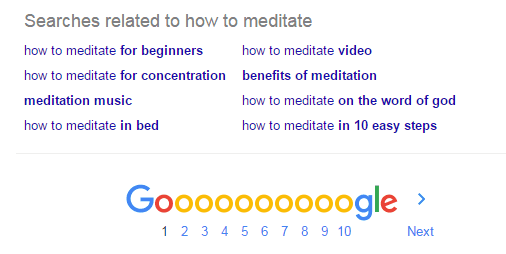
12. Interlink with/from older posts
Interlinking posts with other relevant posts is critical to your SEO. Google likes to see that each main topic, is supported by at least 10 other posts that are about similar topics, or topics in the same niche.
Interlinking, or internal linking is simply something we tend to overlook because it involves going back to old posts and updating them to point to our new posts.
The following should be part of your publishing process for new blogs:
For every new post you're working on, find at least 3 existing related posts on your blog, and then link to them from within the body of that new post. You should also the reverse of this, i.e. have a number of old posts updated to link to the new post.
Even during your keyword research phase, you should focus to make sure that each "main keyword" also has a number of shoulder topics that are meant to be there primarily to support the main topic. These will eventually be linked internally to your main keyword article/page/post.
You probably also have noted how in this post we've linked to multiple supplementary posts. This is something that helps both organic traffic rankings and our visitors because if they need more information about something we are discussing, they can also visit that article.
Most importantly, see which of your posts get the most organic traffic, and link to other pages you want to rank, from those posts. This is because the pages that are getting the most organic traffic have a lot of "strength" they can pass on to the other pages. This is a really great on-page seo trick.
If you have a backlink checker tool, you'll usually use both the organic traffic and the number of links to a certain page to determine its strength.
13. Use alt text for images
Yes, you should use images in your blog content. Posts with images get more clicks.
Images also improve the readability of a post, ensuring there is a longer dwell time (time spent on the page) and a lower bounce rate (people leaving the page and going to another result).
But the thing with images is that Google has no idea what's on them until you find a way to tell them directly. Hence, alt text.
<img src="/img.jpg" alt="what the image is about" />
In WordPress, you can set alt text very easily for every image you have on the blog:

A good practice is to use a short 2-5 word description of what's in the picture, plus include a keyword whenever it makes sense. On to our next step in the on-page seo checklist...
14. Add a Video to your Post
This is an interesting one and most people don't mention this one.
You might now be aware, but Google uses dwell-time, or time spent on a specific page to understand whether it is useful for a user or not. Pages that have a longer dwell-time tend to rank better.
So besides making your post useful, what can you do to increase dwell-time?
A simple solution is to add a video, maybe embedding something from YouTube to your post. By adding a short-video (around 2 minutes) and suggesting to your users that they watch the video, you quickly increase the dwell time of visitors to your page.
Of course, you need to make sure that the video is related to the post (and not from a competitor) because this would be counter-productive. Even other methods to increase dwell-time could make sense, as long as they keep the content useful.
15. Add Outgoing Links to Related Authority Sites
This is another technique that has been proven over and over again in various studies to have positive effects on the ranking of pages.
This is extremely simple to implement. You just need to make sure your article links (using dofollow links) to pages from sites other than your own that have created excellent content that is related to the topic of your post.
What does this is two things:
- Improve the user experience because they can find other useful content to solve their needs
- Put your site in a "cluster" of related sites
The 2nd point essentially means, that by linking to good sites, you are associating yourself with the best sites out there. Your site is mingling with the "in-crowd" so to speak and that sends good signals to your article and site too.
Of course, things to keep in mind, link to articles which you haven't written about yourself on your site, because otherwise you're just boosting your competitors. Also, in general, avoid linking to competitors.
16. Sign up for Google Search Console (GSC)
Google Search Console (or GSC at it is known) is a great tool providing you with various insights about the condition of your site, the indexation status, any issues found, and loads of other useful info.
Listing it all here would take a post of its own. Suffice to say, it's one of your most important tools for WordPress on page optimization. Not only that, it's also completely free.
Signing up is quite easy too. Google takes you step by step through the whole process.
We highly encourage you to spend a while looking at what's available there. For example, you can use the coverage report to understand whether there is a problem with how the Googlebot is crawling your site.

Or you could use the Performance report to understand what pages are bringing you most organic traffic, and which queries...and which aren't. This can help you improve your onpage SEO by creating more and better content for the queries you are not ranking well enough for.
(On a personal note, GSC was the tool that notified me that my site got hacked a while ago. Hadn't it been for them, we probably wouldn't have found out so quickly - of course, if you want to prevent your WordPress website getting hacked - we've got all the steps you need to take.)
Recommended Reading: WordPress Security: The Essential Checklist to Prevent WordPress Hacking [17 actions]
17. Sign up for Bing Webmaster Tools (BWT)
This is an alternative solution to GSC. But you can work with both, GSC and BWT at the same time if you want to.
After all, if you do so, you gain access to additional data and tools, this time, coming from team Bing. No downside.
Go here to find out more and get started.

The URL Inspection is a nifty tool that looks at your on page and makes recommendations that you might have missed. It's perfect for those who want to make sure their WordPress on page is spot on, but are not willing to shell out for any premium SEO tools.

What's next on our on page search engine optimization checklist? Analysis of traffic, because you'll want to know exactly where your traffic is coming from.
18. Use a traffic analytics tool
If you're going to do anything with your website, you need to monitor your traffic on a regular basis. How else are you going to know if your efforts are bringing any results or not?
Now, there are two popular solutions that I like:
- Google Analytics - the most popular traffic tracking tool out there. It also integrates neatly with GSC and you can use it to determine your organic traffic growth overall, any spikes or dips, and the overall website traffic. You can also integrate eCommerce tracking in such a way as to be able how much money your organic traffic is bringing in (as compared to other sources of traffic)
WordPress integration for both of these services is very simple. Both tools give you a piece of Javascript code to place in your site's header or footer and you're done.
19. Make sure your site is mobile-first
In 2025, mobile or smartphones tends to be the preferred way of accessing the web for many internet users. Even if it's not the most preferred way, you'll still find that a significant portion of your traffic will come from handheld devices.
So your website not only needs to cater to this audience, but treat it as the primary audience, what we call mobile-first. Making sites responsive was the recommedation for the last 10 years and it's a given for most sites these days.
Therefore, if your site is still not mobile-first, you're leaving a lot of opportunities on the table and alienating the bigger part of your audience these days.
Remember that, the Google bots are actually crawling the mobile version of your site, rather than the desktop version. So if there is stuff on your desktop version, which does not appear on the mobile-version, Google will not even know about it!
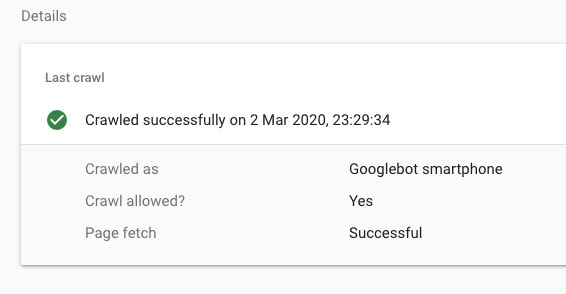
So what to do?
First, check how mobile-friendly your site actually is via Google's dedicated tool.
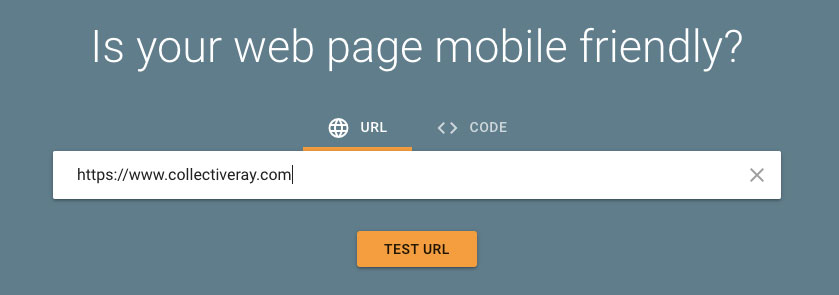
If you get negative results, you can either
- adjust the code of your website theme to make it mobile-friendly (hire someone for this task), and hence search-engine friendly
- change your theme entirely to a fully responsive theme - this is the suggested option. It's good to note that such themes as Divi and Avada are already fully-optimized for mobile access. Check out CollectiveRay's review of Divi and Avada WordPress theme
Frequently Asked Questions
What is on page and off page SEO?
On page SEO is the process that we have detailed above where you perform certain changes to your article and site such that it is easier for search engines to understand what the article is about and be able to rank it better. Off page SEO is anything that is done that is not done on your actual site. The most common off page SEO is working to get links to your site and articles through various link-building strategies.
How do you do on page SEO step by step?
You do on page SEO step by step by following each of the above recommendations to the letter. The most important parts of on page SEO are having the Title tag, H1 and URL of the article containing the keywords you would like to rank for.
Why is on page optimization important?
On page optimization is important because search engines are algorithms that need to understand the content in able to give it good rankings. To understand the relevance of content it has to meet certain criteria. On page optimization ensures that your site meets as many of those criteria as possible such that it performs better in the organic rankings.
Wrapping Up
So ... are you working on your site's on-page search engine optimization?
Are you working proactively to improve your WordPress on-page SEO? Or maybe you just "don't have the time"?
While you think these might not have much effect, doing this iteratively for every post you've published and any new posts will have a dramatic effect over time.
What's left for WordPress SEO checklist?
After you've done all of your WordPress onpage search engine optimization - there is one thing still left to do. This is offpage optimization.
If we had to simply answer the question what is onpage vs off page seo, the answer is quite simple. The changes which are done on your actual website (i.e. all of the above, is on-page). Off-page is all of your link building efforts towards the content you are writing. But that is another topic for another time :)
What steps have we missed in our SEO checklist? Let us know in the comments below.

